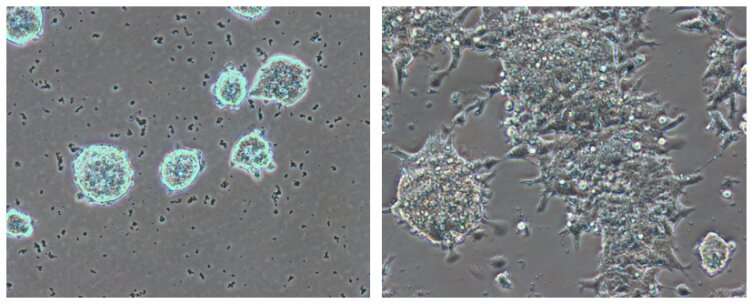Researchers describe how embryonic stem cells keep optimal conditions for use in regenerative medicine

Scientists at the Proteomics Core Unit of the Spanish National Cancer Research Centre (CNIO), headed by Javier Muñoz, have described the mechanisms, unknown to date, involved in maintaining embryonic stem cells in the best possible state for their use in regenerative medicine. Their results, published in Nature Communications, will help to find novel stem-cell therapies for brain stroke, heart disease or neurodegenerative conditions like Alzheimer's or Parkinson's disease.
Naïve pluripotent stem cells, ideal for doing research
Embryonic stem cells (ESCs) are pluripotent cells that can grow into all somatic cell types—a characteristic that is extremely useful for researchers and regenerative medicine. There are two types of pluripotency: naïve and primed. The naïve state comes before the primed one during embryonic development. Naïve ESCs have the potential to differentiate into any cell types. Thus, they are more relevant in research. However, the naïve state is unstable, because naïve ESCs are constantly receiving signals that regulate the transition to the primed state and their self-renewal. Understanding the mechanisms that regulate the pluripotent states is important because they might help achieve long-term maintenance of stable naïve pluripotent stem cells in ESC cultures.
Traditionally, maintenance of naïve ESC cultures is based on the inhibition of two of the signaling pathways that regulate cell differentiation—aka as the 2i culture method. Recently, naïve ESCs have been maintained adopting a totally different approach, namely, the inhibition of Cdk8/19, a protein that regulates the expression of numerous genes, including the genes that help maintain the naïve state. "While the two approaches are used to culture naïve cells, little is known about the mechanisms involved," says Javier Muñoz, who led the study.
Now, using proteomics, the large-scale characterisation of proteins coded in a genome, CNIO scientists have described a large number of the molecular events that help stabilize these valuable ESC. "This is the first time proteomics has been used in this context," says Ana Martínez del Val, from the Proteomics Core Unit at CNIO, first author of the article. "We analyzed the mechanisms at a number of levels. First, we conducted phosphoproteomic analyses, studying phosphorylated proteins. Phosphorylation regulates protein functions (by activating or inhibiting them). Second, we analyzed the expression of these proteins. Finally, we identified changes in metabolites (reaction intermediates or end products). With our integrated approach, we got an accurate picture of the causes of the high degree of plasticity of ESC," Martínez del Val explains.
The results of the study might have implications for research on some types of cancer. We know that "the inhibition of Cdk8 leads to reduced cell proliferation in acute myeloid leukemia by enhancing tumor suppressors", and that "Cdk8 is a colorectal cancer oncogene." "Cdk8 activity is somehow enigmatic, since its functions vary considerably with the cell environment," says Muñoz. "We have identified a number of Cdk8 targets that were unknown until now. This can help understand the function this protein regulates in other biological contexts."
Going beyond genomics with proteomics
The study by the CNIO team shows the need for a greater focus on proteomics in cancer research strategies.
Research into and treatment of disease have made huge progress in the past decades, courtesy of the techniques used in molecular biology. Two of the most frequently used techniques are genomics, the analysis of the DNA sequence—the molecule that carries all our genetic information—and transcriptomics, the study of the sets of RNA transcripts—the molecules that translate into proteins. Proteins are macromolecules that are directly involved in chemical processes essential for life. The proteomic approach was adopted relatively recently by biomedical researchers. Proteomics has gained momentum over the past 15 years, yet it has become essential for genomics and transcriptomics to come full circle. Genomics and proteomics study processes that take place before proteins are produced. "We use proteomics to study a number of properties of proteins that cannot be analyzed by studying DNA or RNA," says Martínez del Val. This is extremely important, since "proteins are responsible for a whole range of basic life functions that take place within cells," Muñoz adds.
More information: Ana Martinez-Val et al, Dissection of two routes to naïve pluripotency using different kinase inhibitors, Nature Communications (2021). DOI: 10.1038/s41467-021-22181-5


















